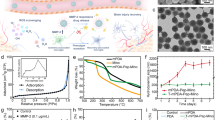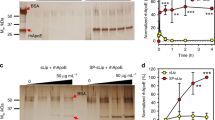Abstract
There is an urgent need to develop new therapeutic approaches for the treatment of severe neurological trauma, such as stroke and spinal cord injuries. However, many drugs with potential neuropharmacological activity, such as adenosine, are inefficient upon systemic administration because of their fast metabolization and rapid clearance from the bloodstream. Here, we show that conjugation of adenosine to the lipid squalene and the subsequent formation of nanoassemblies allows prolonged circulation of this nucleoside, providing neuroprotection in mouse stroke and rat spinal cord injury models. The animals receiving systemic administration of squalenoyl adenosine nanoassemblies showed a significant improvement of their neurologic deficit score in the case of cerebral ischaemia, and an early motor recovery of the hindlimbs in the case of spinal cord injury. Moreover, in vitro and in vivo studies demonstrated that the nanoassemblies were able to extend adenosine circulation and its interaction with the neurovascular unit. This Article shows, for the first time, that a hydrophilic and rapidly metabolized molecule such as adenosine may become pharmacologically efficient owing to a single conjugation with the lipid squalene.
This is a preview of subscription content, access via your institution
Access options
Subscribe to this journal
Receive 12 print issues and online access
$259.00 per year
only $21.58 per issue
Buy this article
- Purchase on Springer Link
- Instant access to full article PDF
Prices may be subject to local taxes which are calculated during checkout






Similar content being viewed by others
Change history
03 December 2014
In the version of this Article originally published, the affiliations of Hakan Eroglu, Omer Faruk Turkoglu, Seçil Caban, Oya Tagit, Niko Hildebrandt and Yilmaz Capan were incorrect. This error has now been corrected in the online versions of the Article.
References
Profyris, C. et al. Degenerative and regenerative mechanisms governing spinal cord injury. Neurobiol. Dis. 15, 415–436 (2004).
Pardridge, W. M. Non-invasive drug delivery to the human brain using endogenous blood–brain barrier transport systems. Pharm. Sci. Technol. Today 2, 49–59 (1999).
Palmer, A. M. & Alavijeh, M. S. Translational CNS medicines research. Drug. Discov. Today 17, 1068–1078 (2012).
Pangalos, M. N., Schechter, L. E. & Hurko, O. Drug development for CNS disorders: strategies for balancing risk and reducing attrition. Nature Rev. Drug Discov. 6, 521–532 (2007).
Zhang, L., Zhang, Z. G. & Chopp, M. The neurovascular unit and combination treatment strategies for stroke. Trends Pharmacol. Sci. 33, 415–422 (2012).
Andrieux, K. & Couvreur, P. Polyalkylcyanoacrylate nanoparticles for delivery of drugs across the blood–brain barrier. Wiley Interdiscip. Rev. Nanomed. Nanobiotechnol. 1, 463–474 (2009).
Nair, S. B., Dileep, A. & Rajanikant, G. K. Nanotechnology based diagnostic and therapeutic strategies for neuroscience with special emphasis on ischemic stroke. Curr. Med. Chem. 19, 744–756 (2012).
Sun, Q., Radosz, M. & Shen, Y. Challenges in design of translational nanocarriers. J. Control Rel. 164, 156–169 (2012).
Yang, H. Nanoparticle-mediated brain-specific drug delivery, imaging, and diagnosis. Pharm. Res. 27, 1759–1771 (2010).
Boison, D. Adenosine as a neuromodulator in neurological diseases. Curr. Opin. Pharmacol. 8, 2–7 (2008).
De Mendonca, A., Sebastiao, A. M. & Ribeiro, J. A. Adenosine: does it have a neuroprotective role after all? Brain Res. Rev. 33, 258–274 (2000).
Williams-Karnesky, R. L. & Stenzel-Poore, M. P. Adenosine and stroke: maximizing the therapeutic potential of adenosine as a prophylactic and acute neuroprotectant. Curr. Neuropharmacol. 7, 217–227 (2009).
Fredholm, B. B., Chen, J. F., Cunha, R. A., Svenningsson, P. & Vaugeois, J. M. Adenosine and brain function. Int. Rev. Neurobiol. 63, 191–270 (2005).
Gomes, C. V., Kaster, M. P., Tome, A. R., Agostinho, P. M. & Cunha, R. A. Adenosine receptors and brain diseases: neuroprotection and neurodegeneration. Biochim. Biophys. Acta 1808, 1380–1399 (2011).
Moser, G. H., Schrader, J. & Deussen, A. Turnover of adenosine in plasma of human and dog blood. Am. J. Physiol. 256, C799–C806 (1989).
Cerqueira, M. D., Verani, M. S., Schwaiger, M., Heo, J. & Iskandrian, A. S. Safety profile of adenosine stress perfusion imaging: results from the Adenoscan Multicenter Trial Registry. J. Am. Coll. Cardiol. 23, 384–389 (1994).
Levine, A. S. & Morley, J. E. Purinergic regulation of food intake. Science 217, 77–79 (1982).
Basheer, R., Strecker, R. E., Thakkar, M. M. & McCarley, R. W. Adenosine and sleep–wake regulation. Prog. Neurobiol. 73, 379–396 (2004).
Pardridge, W. M., Yoshikawa, T., Kang, Y. S. & Miller, L. P. Blood–brain barrier transport and brain metabolism of adenosine and adenosine analogs. J. Pharmacol. Exp. Ther. 268, 14–18 (1994).
Isakovic, A. J., Abbott, N. J. & Redzic, Z. B. Brain to blood efflux transport of adenosine: blood–brain barrier studies in the rat. J. Neurochem. 90, 272–286 (2004).
Couvreur, P. et al. Squalenoyl nanomedicines as potential therapeutics. Nano Lett. 6, 2544–2548 (2006).
Reddy, L. H. et al. Preclinical toxicology (subacute and acute) and efficacy of a new squalenoyl gemcitabine anticancer nanomedicine. J. Pharmacol. Exp. Ther. 325, 484–490 (2008).
Hillaireau, H. et al. Anti-HIV efficacy and biodistribution of nucleoside reverse transcriptase inhibitors delivered as squalenoylated prodrug nanoassemblies. Biomaterials 34, 4831–4838 (2013).
Bisgaier, C. L., Minton, L. L., Essenburg, A. D., White, A. & Homan, R. Use of fluorescent cholesteryl ester microemulsions in cholesteryl ester transfer protein assays. J. Lipid Res. 34, 1625–1634 (1993).
Kitagawa, H., Mori, A., Shimada, J., Mitsumoto, Y. & Kikuchi, T. Intracerebral adenosine infusion improves neurological outcome after transient focal ischemia in rats. Neurol. Res. 24, 317–323 (2002).
Tatlisumak, T. et al. Delayed treatment with an adenosine kinase inhibitor, GP683, attenuates infarct size in rats with temporary middle cerebral artery occlusion. Stroke 29, 1952–1958 (1998).
Pignataro, G., Simon, R. P. & Boison, D. Transgenic overexpression of adenosine kinase aggravates cell death in ischemia. J. Cereb. Blood Flow Metab. 27, 1–5 (2007).
Von Lubitz, D. K. Adenosine and cerebral ischemia: therapeutic future or death of a brave concept? Eur. J. Pharmacol. 371, 85–102 (1999).
Echavarria-Pinto, M. et al. Low coronary microcirculatory resistance associated with profound hypotension during intravenous adenosine infusion: implications for the functional assessment of coronary stenoses. Circ. Cardiovasc. Interv. 7, 35–42 (2014).
Go, A. S. et al. Heart disease and stroke statistics—2014 update: a report from the American Heart Association. Circulation 129, e28–e292 (2014).
Yemisci, M. et al. Pericyte contraction induced by oxidative-nitrative stress impairs capillary reflow despite successful opening of an occluded cerebral artery. Nature Med. 15, 1031–1037 (2009).
Hamilton, N. B., Attwell, D. & Hall, C. N. Pericyte-mediated regulation of capillary diameter: a component of neurovascular coupling in health and disease. Front. Neuroenerg. 2, 1–14 (2010).
Li, S. et al. Intracellular ATP concentration contributes to the cytotoxic and cytoprotective effects of adenosine. PLoS ONE 8, e76731 (2013).
Paterniti, I. et al. Selective adenosine A2A receptor agonists and antagonists protect against spinal cord injury through peripheral and central effects. J. Neuroinflam. 8, 31 (2011).
Okonkwo, D. O. et al. A comparison of adenosine A2A agonism and methylprednisolone in attenuating neuronal damage and improving functional outcome after experimental traumatic spinal cord injury in rabbits. J. Neurosurg. Spine 4, 64–70 (2006).
Kwon, B. K., Hillyer, J. & Tetzlaff, W. Translational research in spinal cord injury: a survey of opinion from the SCI community. J. Neurotrauma 27, 21–33 (2010).
Basso, D. M., Beattie, M. S. & Bresnahan, J. C. Graded histological and locomotor outcomes after spinal cord contusion using the NYU weight-drop device versus transection. Exp. Neurol. 139, 244–256 (1996).
Shi, Y. et al. Effective repair of traumatically injured spinal cord by nanoscale block copolymer micelles. Nature Nanotech. 5, 80–87 (2010).
Alavijeh, M. S. & Palmer, A. M. Measurement of the pharmacokinetics and pharmacodynamics of neuroactive compounds. Neurobiol. Dis. 37, 38–47 (2010).
Levine, A. S. & Morley, J. E. Effect of intraventricular adenosine on food intake in rats. Pharmacol. Biochem. Behav. 19, 23–26 (1983).
Portas, C. M., Thakkar, M., Rainnie, D. G., Greene, R. W. & McCarley, R. W. Role of adenosine in behavioral state modulation: a microdialysis study in the freely moving cat. Neuroscience 79, 225–235 (1997).
Porkka-Heiskanen, T., Alanko, L., Kalinchuk, A. & Stenberg, D. Adenosine and sleep. Sleep Med. Rev. 6, 321–332 (2002).
Melani, A., Corti, F., Cellai, L., Giuliana Vannucchi, M. & Pedata, F. Low doses of the selective adenosine A2A receptor agonist CGS21680 are protective in a rat model of transient cerebral ischemia. Brain Res. 1551, 59–72 (2014).
Poller, B. et al. The human brain endothelial cell line hCMEC/D3 as a human blood–brain barrier model for drug transport studies. J. Neurochem. 107, 1358–1368 (2008).
Acknowledgements
The research leading to these results received funding from the European Research Council (allocated to P.C.), under the European Community's Seventh Framework Programme FP7/2007-2013 (grant agreement no. 249835). A.G. is supported by a NerF-ENP fellowship provided by the Région Ile-de-France. T.D.'s work is supported by the Turkish Academy of Sciences. M.Y. is supported by a limited grant by L'Oréal, Turkey. H.E. has been supported by the Hacettepe University Scientific Research Project (project no. 013D04301002). O.T. is supported by the European Union Seventh Framework Programme FP7/2007-2013 (grant agreement no. 246556). The authors thank D. Sobot (Institut Galien Paris-Sud XI) for help with flow cytometry experiments, O. Bawa and P. Opolon (Institut Gustave Roussy) for analysis of the morphology on stained slides, M. Wittner (Institut Gustave Roussy) for the haematology study, S. Beurlet (VEBIO Lab) for biochemical dosages and M. Parrod (Bertin PHARMA) for the radio-HPLC analysis.
Author information
Authors and Affiliations
Contributions
P.C. and T.D. conceived and designed the research. A.G. designed and performed the nanoparticle preparation, the side effects and toxicity experiments, the stability and in vivo pharmacokinetic/biodistribution studies and the in vitro experiments. S.L. developed and performed the SQAd synthesis, D.D. helped with analysing the chemical results. B.R., S.G.A., G.P. and O.L. developed and performed the radiolabelled compound synthesis. T.D. and M.Y. designed and performed the cerebral ischaemia experiments. B.D-D. performed the histological stainings and countings for cerebral ischaemia experiments. S.C. and Y.C. were in charge of nanoparticle preparation for the cerebral ischaemia experiments. H.E., O.F.T. and A.G. designed and performed the spinal cord injury experiments. M.F.Z. performed the ultrastructural evaluation of the spinal cord injury experiments. A.G., O.T. and N.H designed and performed the FRET nanoassemblies experiments. Y.L.D and A.G. performed the sleep cycle experiments. J.M. performed the HPLC analysis. S.V. performed the complement activation experiments. H.C. helped to analyse the radioactivity data and V.N. helped to analyse the confocal data. P.C., T.D., K.A., A.G. and M.Y. co-wrote the paper. All authors discussed the results and commented on the manuscript.
Corresponding authors
Ethics declarations
Competing interests
The authors declare no competing financial interests.
Supplementary information
Supplementary information
Supplementary Information (PDF 1722 kb)
Supplementary information
Supplementary Movie 1 (AVI 37615 kb)
Rights and permissions
About this article
Cite this article
Gaudin, A., Yemisci, M., Eroglu, H. et al. Squalenoyl adenosine nanoparticles provide neuroprotection after stroke and spinal cord injury. Nature Nanotech 9, 1054–1062 (2014). https://doi.org/10.1038/nnano.2014.274
Received:
Accepted:
Published:
Issue Date:
DOI: https://doi.org/10.1038/nnano.2014.274
This article is cited by
-
Mesoporous polydopamine delivering 8-gingerol for the target and synergistic treatment to the spinal cord injury
Journal of Nanobiotechnology (2023)
-
Self-assembled lipid–prodrug nanoparticles
Nature Reviews Bioengineering (2023)
-
The role of the ATP-adenosine axis in ischemic stroke
Seminars in Immunopathology (2023)
-
Polymeric Nanoparticles in Hybrid Catalytic Processing and Drug Delivery System
Topics in Catalysis (2022)
-
Fabrication of Gallic Acid Loaded SeNPs and their Neuroprotection Effect for Treatment of Ischemic Stroke
Journal of Cluster Science (2022)



